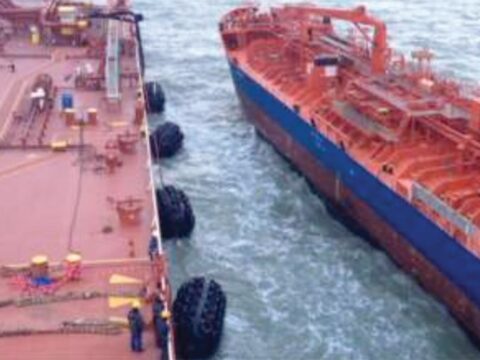A well-coordinated unmoorng after a ship-to-ship transfer while underway gives more “leverage” over external forces such as current. The Nautical Institute says this in it latest Mars Report, in which the unmooring took place while lying still and resulted in the two vessels colliding.
The Nautical Institute gathers reports of maritime accidents and near-misses. It then publishes these so-called Mars Reports (anonymously) to prevent other accidents from happening. A summary of this incident:
A tanker was anchored with nine port shackles in the water, awaiting the arrival of the receiving vessel to carry out an STS transfer operation. The compatibility of the vessels for STS operations had been confirmed by the STS organiser and a pre-transfer information exchange between the two vessels had been done. Fenders were rigged at the starboard side to accommodate the receiving vessel. The receiving vessel berthed without incident and the STS transfer was completed over approximately twelve hours.
Unmooring then commenced under the supervision of the STS supervisor, who was on board the receiving vessel. The STS supervisor first requested the discharging vessel to heave up five shackles and remain anchored with four shackles in the water. Unmooring then commenced.
Also read: ‘Questionable decisions’ during ship-to-ship transfer end in tragedy
Within ten minutes, the receiving vessel started moving away from the discharging vessel using its bow thruster and main engine. When the distance between the vessels was about 15-20 metres, the STS supervisor thought that the bow thruster of the receiving vessel was sucking a fender rope, so he stopped the thruster. Within seconds, the prevailing current caused the bow of the receiving vessel to drift towards the discharging vessel. The two vessels came into slight contact.

The unmooring manoeuvre was suspended and the discharging vessel was instructed by the STS supervisor to heave up its anchor fully. Once the anchor was retrieved, the unmooring operation was resumed underway and the vessels successfully separated. Except for paint scratches, no damage or deformation to vessel’s side shell was observed.
Advice from The Nautical Institute
- Weather conditions were optimum, and as such, the unmooring operation could have been carried out safely with both vessels underway – which is how it was accomplished after the incident. A well-coordinated ship-to-ship (STS) unmooring while underway gives more “leverage” over external forces such as current.
- Fenders may be secured on either vessel, but contacting an unprotected portion of the hull is less likely if the fenders are rigged on the manoeuvring ship.
Also read: Terminal pressures vessel crew to resume transfer despite safety issues
Mars Report editor’s note
STS best practices can be found on the Skuld website. The most common incident during STS operations is contact/collision between the two ships while manoeuvring alongside each other, or upon departing. There are many reasons for this, including:
- Incorrect approach angle between the manoeuvring vessel and constant heading (mother) ship;
- The manoeuvring ship approaching at excessive speed;
- Failure of one or both ships to appreciate meteorological and/or tidal conditions;
- If underway; the mother vessel not maintaining a constant heading and speed;
- If at anchor; the mother vessel failing to control excessive swinging and/or the manoeuvring ship failing to appreciate the swing;
- Miscommunication between the vessels during manoeuvring;
- Bridge wing to bridge wing touch for ships of similar length.
Mars Reports
This accident was covered in the Mars Reports, originally published as Mars 202152, that are part of Report Number 348. A selection of this Report will also be published in SWZ|Maritime’s November 2021 issue. The Nautical Institute compiles these reports to help prevent maritime accidents. That is why they are also published on SWZ|Maritime’s website.
More reports are needed to keep the scheme interesting and informative. All reports are read only by the Mars coordinator and are treated in the strictest confidence. To submit a report, please use the Mars report form.








